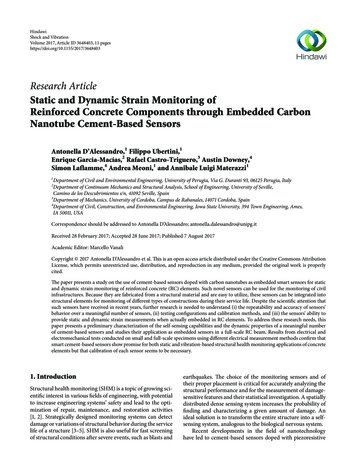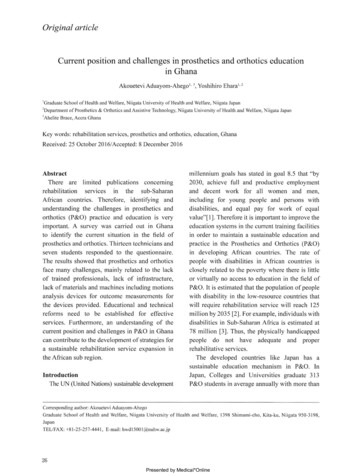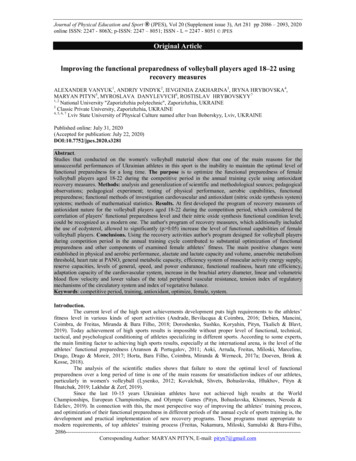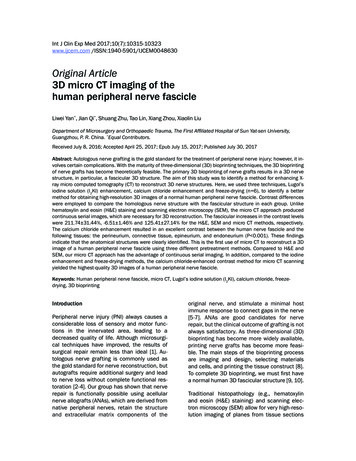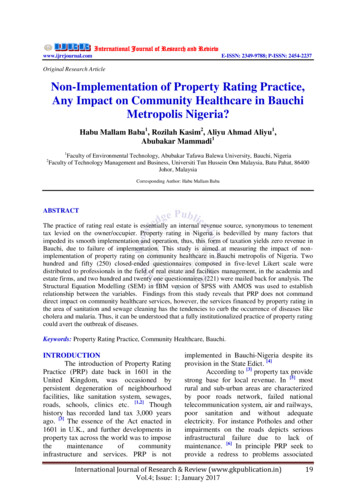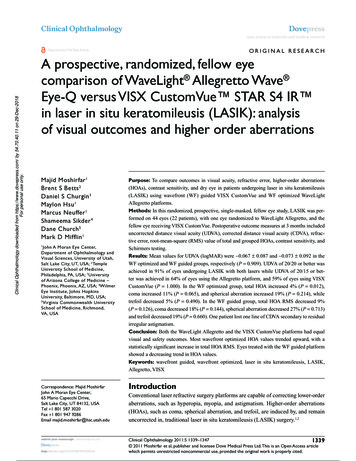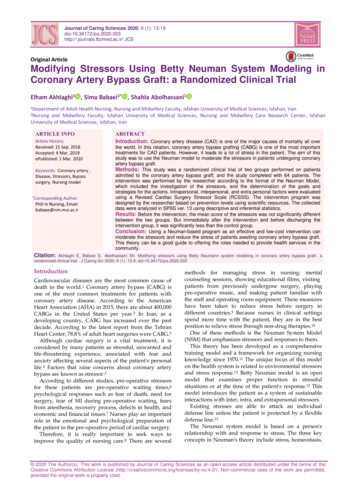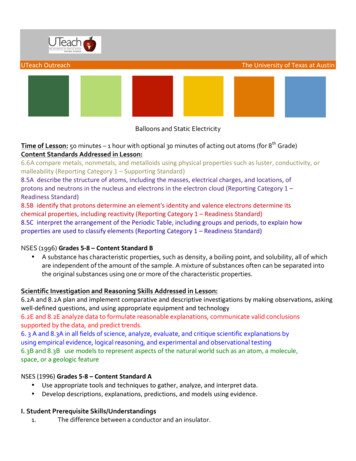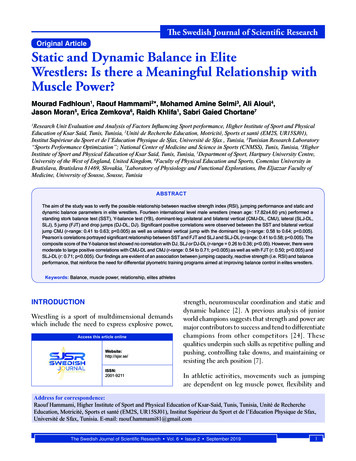
Transcription
The Swedish Journal of Scientific ResearchOriginal ArticleStatic and Dynamic Balance in EliteWrestlers: Is there a Meaningful Relationship withMuscle Power?Mourad Fadhloun1, Raouf Hammami2*, Mohamed Amine Selmi3, Ali Aloui4,Jason Moran5, Erica Zemkova6, Raidh Khlifa1, Sabri Gaied Chortane7Research Unit Evaluation and Analysis of Factors Influencing Sport performance, Higher Institute of Sport and PhysicalEducation of Ksar Said, Tunis, Tunisia, 2Unité de Recherche Education, Motricité, Sports et santé (EM2S, UR15SJ01),Institut Supérieur du Sport et de l’Education Physique de Sfax, Université de Sfax , Tunisia, 3Tunisian Research Laboratory“Sports Performance Optimization”; National Center of Medicine and Science in Sports (CNMSS), Tunis, Tunisia, 4HigherInstitute of Sport and Physical Education of Ksar Said, Tunis, Tunisia, 5Department of Sport, Hartpury University Centre,University of the West of England, United Kingdom, 6Faculty of Physical Education and Sports, Comenius University inBratislava, Bratislava 81469, Slovakia, 7Laboratory of Physiology and Functional Explorations, Ibn Eljazzar Faculty ofMedicine, University of Sousse, Sousse, Tunisia1ABSTRACTThe aim of the study was to verify the possible relationship between reactive strength index (RSI), jumping performance and static anddynamic balance parameters in elite wrestlers. Fourteen international level male wrestlers (mean age: 17.82 4.60 yrs) performed astanding stork balance test (SST), Y-balance test (YB), dominant-leg unilateral and bilateral vertical (CMJ-DL, CMJ), lateral (SLJ-DL,SLJ), 5 jump (FJT) and drop jumps (DJ-DL, DJ). Significant positive correlations were observed between the SST and bilateral verticaljump CMJ (r-range: 0.41 to 0.63; p 0.005) as well as unilateral vertical jump with the dominant leg (r-range: 0.58 to 0.64; p 0.005).Pearson’s corelations portrayed significant relationship between SST and FJT and SLJ and SLJ-DL (r-range: 0.41 to 0.58; p 0.005). Thecomposite score of the Y-balance test showed no correlation with DJ, SLJ or DJ-DL (r-range 0.26 to 0.36; p 0.05). However, there weremoderate to large positive correlations with CMJ-DL and CMJ (r-range: 0.54 to 0.71; p 0.005) as well as with FJT (r: 0.50; p 0.005) andSLJ-DL (r: 0.71; p 0.005). Our findings are evident of an association between jumping capacity, reactive strength (i.e. RSI) and balanceperformance, that reinforce the need for differential plyometric training programs aimed at improving balance control in elites wrestlers.Keywords: Balance, muscle power, relationship, elites athletesINTRODUCTIONWrestling is a sport of multdimensional demandswhich include the need to express explosive power,Access this article h, neuromuscular coordination and static anddynamic balance [2]. A previous analysis of juniorworld champions suggests that strength and power aremajor contributors to success and tend to differentiatechampions from other competitors [24]. Thesequalities underpin such skills as repetitive pulling andpushing, controlling take downs, and maintaining orresisting the arch position [7].In athletic activities, movements such as jumpingare dependent on leg muscle power, flexibility andAddress for correspondence:Raouf Hammami, Higher Institute of Sport and Physical Education of Ksar-Said, Tunis, Tunisia, Unité de RechercheEducation, Motricité, Sports et santé (EM2S, UR15SJ01), Institut Supérieur du Sport et de l’Education Physique de Sfax,Université de Sfax, Tunisia. E-mail: raouf.hammami81@gmail.comThe Swedish Journal of Scientific Research Vol. 6 Issue 2 September 20191
Fadhloun, et al.: Static and dynamic balance in elite wrestlerstechnique [7]. Also, deficits in muscle strength andpower can lead to impaired balance and, therefore,lower performance levels [3, 15, 5, 14]. The citedstudies highlight the importance of the interactionbetween strength, power and balance on performancequalities and, on this basis, the targeting of thesethrough systematic training for wrestling is justified.Balance is defined as the ability of the centre of thebody to remain stable with minimal movement [29].A balanced state is achieved through the combination ofseveral mechanisms such as muscle coordination and bodysensory organisation which are two important componentscontrolled by the central nervous system [11]. Two typesof balance, static and dynamic, are mentioned in theliterature and various study protocols have been usedto assess these. The standing stork test (SST) and theY-balance Test (YB) are considered the most popularassessments of static and dynamic balance [23] butdespite this, there has been minimal analysis of howbalance, as measured by these functional tests, relatesto sport-specific actions such as hopping and jumping.Booysen et al. [3] demonstrated a significant corelationbetween YB and countermovement jump (CMJ) inuniversity (n 27, mean age 20.7 1.84 years;r 0.4, p 0.004) and professional athletes (n 23, meanage 23.0 3.08 years; r 0.56, p 0.006). Author’sshowed moderate association between vertical jumpingability and dynamic balance when using the non-dominantleg. Johnson (2011) [16] observed difference betweenpower-trained and endurance athletes in response to anexternal perturbations in a bilateral stance. Furthermore,significant relationship were observed between BalanceError Scoring System score test and standing long jump(r 0.641) and triple hop (r 0.520–0.636) performancein 22 elite Turkish athletes [5]. Also, Basar et al., [2]demonstrated a strong correlation (r 0.65) betweenstatic balance with maximum ice-skating speed in highschool ice hockey players. In contrast, a non-significantassociation between dynamic balance performed withdominant leg for stance and countermovement jumpheight was found in both healthy young and middle-agedadults. Author’s concluded that theses neuromuscularcapabilities are independant of each other and should bedevelopped simultanuesly in order to prevent injuries [21].Zemkova et al. (2017) [30]demonstrated no significantrelationship between postural perturbation and maximumvoluntary isometric contraction, peak force, peak rate offorce development and peak power during jumping inyoung adults, the authors concluding that the compositionof postural stimuli strongly influenced compensatoryresponse effects on muscle power. Improvement inpostural control, jumping height and rate of forcedevelopment were observed after 4-week balance-trainingprogram integrated into high school physical educationlessons [9]. Author’s also stated that postural instabilitywas a result of a significant impairments in force, power,movement velocity, and range of motion. Consequently,better scores in balance performance was associated withstrength performance and this could positively impacttrunk stability as well as rate of force development [10],which could, in turn, influence dynamic activities suchas jumping and hopping.For the above reasons, it is important to considerjumping and balance performance together in athletes;however, to our knowledge, no study charachterises therelationship between jumping technique and staticand dynamic balance. In light of the points made,this study aims to determine the association betweenreactive strength, jumping performance and static anddynamic balance parameters in young elite wrestlers.MATERIAL AND METHODSubjectsDescriptive data for the participants can be seen inTable 1. Fourteen high level elite male wrestlers fromTable 1. Descriptive statistics and Reliability of theapplied tests for group (n 14)VariablesM SDICC (95% IC)SEMAge (yrs)17.82 4.60‑‑Body mass (Kg)69.49 14.21‑‑Height (cm)162.9 4.10‑‑IMC (Kg.m )22.79 4.16‑‑Leg length (cm)98.71 10.33‑‑CMJ (cm)32.46 4.930.86 (0.55‑0.95)1.84DJ (cm)187.9 59.230.93 (0.77‑0.97)4.11.02 0.240.84 (0.50‑0.95)0.09FJT (m)10.57 0.530.83 (0.47‑0.95)0.21SLJ (cm)187.9 59.230.95 (0.85‑0.98)2.06‑2RSI (mm ms 1)CMJ‑DL (cm)DJ‑DL (cm)RSI‑DL (mm ms ) 1SLJ‑DL (cm)13.1 2.950.88 (0.61‑0.96)1.00186.0 22.360.90 (0.68‑097)0.063.61 2.170.95 (0.88‑0.98)0.43186.0 22.360.81 (0.39‑0.94)1.02CMJ – countermovement jump; DJ‑ drop jump; RSI‑ strengthreactive index; FJT‑ five jump test; SLJ – standing lateral jump;CMJ‑DL – countermovement jump with dominant leg; DJ‑DL‑ drop jumpwith dominant leg; RSI‑DL – strength reactive index with dominant leg;SLJ‑DL‑ standing lateral jump with dominant leg; SEM – Standart Error ofEstimate; ICC – intra‑class coefficient; CI – confidence interval.The Swedish Journal of Scientific Research Vol. 6 Issue 2 September 20192
Fadhloun, et al.: Static and dynamic balance in elite wrestlersthe national team of Tunisia and participated in anOlympic competition (mean age: 17.8 4.6 [years];body mass: 69.5 14.2 [kg]; body mass index [BMI]:22.8 4.2 [kg · m 2]; Height: 162.9 4.1 [cm]; Leglength: 98.7 10.3 [cm]), volunteered to participate inthe study. Participants had a mean training experienceof 5 3.79 years and engaged in at least five trainingsessions and one competition per week. None had beenexposed to balance/perturbation training prior to thisstudy. Testing was performed during the pre-seasonduring March and April. The study was conductedaccording to the Declaration of Helsinki, and allathletes received a clear explanation of the study,including the risks and benefits of participation; writteninformed consent was obtained from their parents/responsible adults prior to testing, and the athletesthemselves agreed to participate in the study.DESIGN AND PROCEDURESIn addition to body mass (in kg), body height (in cm)and the body mass index (BMI), the testing in thisstudy included indices of static and dynamic balancetesting, power testing and reactive strength testing.The testing was done in an indoor center of wrestling.One week before the commencement of the study, allthe subjects participated in an orientation session tobecome familiar with the testing procedures.With a Static balance protocol (SST) [13] subject stoodon the dominant leg with his opposite foot against theinside of the supporting knee with both hands on thehips. Then he raised the heel of his foot from the floorand attempted to maintain balance control for as long aspossible. The trial ended if the subject either moved hishands from his hips, the ball of the dominant foot movedfrom its original position, or if the heel touched the floor.This test was carried out with eyes opened as well as witheyes closed and was timed (seconds) using a stop-watch.The recorded score was the best of three attempts.With the YB test, and for each trial, subjects placedtheir hands on their hips and began in a unilateralstance with the most distal aspect of their great toebehind the line on the centre of tape. Distances werethen recorded by pushing the target reach indicator inthe 3 directions and trials were performed on dominantleg. Throughout, subjects were required to keep theheel of the non-reach leg on the testing platform,maintain balance in a single leg stance, and return thereach foot back to the start prior to attempting the nextdirection. Also, no visible kicking of the target reachindicator was permitted. Maximal reach distances wererecorded to the nearest 0.5 cm marker on the Y-balancekit. Balance performance was calculated as the YBTcomposite score (MADX [%]), obtained by dividingthe sum of the maximal reached distances in the threedirections by three times the length of the lower limb(LL; measured from the most distal end of the anteriorsuperior iliac spine to the most distal end of the medialmalleolus of each limb), then multiplied by 100: MADX% {[(A PM PL)/(LL 3)] 100}. [22].Participants also performed vertical jumps: unilateralon the dominant leg (CMJ-DL) and bilateral CMJ.They were instructed to jump as high as possibleand verbal encouragement was provided before eachtrial. All vertical jump tests were performed using anErgojump system (ErgojumpP apparatus; Globus Italia,Codogne, Italy), which recorded jump height, with apassive rest of 1 min between each repetitions and3 min between each test.This five jump Test (FJT) test consisted of fiveconsecutive unilateral strides from the startingposition with a leg of the participant’s choice. Eachstride alternated between legs and the test culminatedwith a bilateral landing. Performance on the test wasmeasured with a tape measure from the front edgeof the subject’s feet in the start position to the rearedge of the feet in the finishing position. Test-retestassessment demonstrated high reliability for elitesathletes (TEM 2.3%, ICC 0.94) [26].For the standing lateral jump (SLJ) and standinglateral jump on the dominant leg (SLJ-DL), eachparticipant began by standing, either bilaterally (SLJ)or unilaterally on their dominant leg (SLJ-DL), withthe foot at the starting line and hands on the hips. Eachparticipant was instructed to sink to a self-selecteddepth and to jump laterally to the inside as far aspossible, landing on two feet for the bilateral jump(SLJ) and one foot for the unilateral jump (SLJ-DL).The distance jumped was measured to the nearest0.01 m with a tape measure [19].For strength reactive index (RSI), each participantperformed two maximal effort drop jumps (DJ) frombox heights of 30 cm with approximately 30 seconds ofrest between each trial. RSI (mm/ms) was determinedby dividing jump height by contact time [6]. All DJtrials were undertaken bilaterally and unilaterally onThe Swedish Journal of Scientific Research Vol. 6 Issue 2 September 20193
Fadhloun, et al.: Static and dynamic balance in elite wrestlersthe dominant leg (DJ-DL) and were supervised by acertified training practitioner.STATISTICAL ANALYSISAll data were verified for normal distribution using theKolmogorov-Smirnov test and were presented as meansand standard deviations (SD). Test retest reliability forthe variables was computed using intraclass correlationcoefficients. A paired sample t-test was used to det
The standing stork test (SST) and the Y-balance Test (YB) are considered the most popular assessments of static and dynamic balance [23] but despite this, there has been minimal analysis of how balance, as measured by these functional tests, relates to sport-specific actions such as hopping and jumping. Booysen et al. [3] demonstrated a significant corelation between YB and countermovement .
